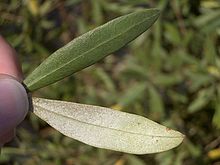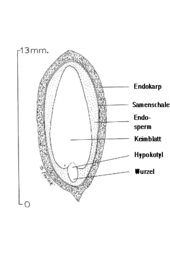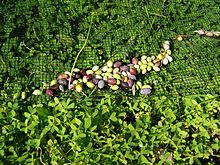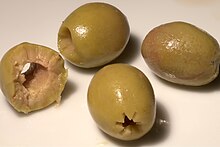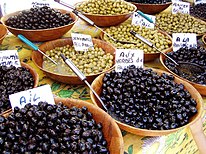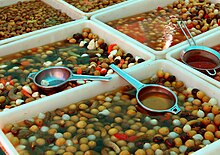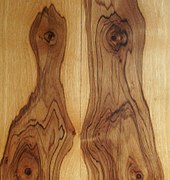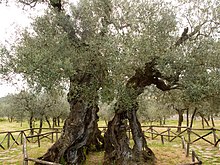Olive tree
| Olive tree | ||||||||||||
|---|---|---|---|---|---|---|---|---|---|---|---|---|

Olea europaea - Illustration from “Koehler's Medicinal Plants” from 1887. A: Flowering branch |
||||||||||||
| Systematics | ||||||||||||
|
||||||||||||
| Scientific name | ||||||||||||
| Olea europaea | ||||||||||||
| L. |
The olive tree ( Olea europaea ), also known as the real olive tree , is a medium-sized tree from the genus of the olive trees ( Olea ), which belongs to the olive family (Oleaceae) , which is often gnarled when old . He is since the 4th millennium BC. Cultivated as a useful plant.
description
Habit and trunk
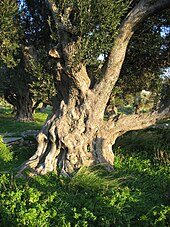
The olive tree grows as a richly branched, evergreen tree or shrub and reaches (depending on the variety) stature heights of 10 to 20 meters. The wild olive trees are smaller than the cultivars. Young twigs are a bit angular. The green-gray, smooth bark of young twigs, the leaf stalks and the leaf blade are intensely silver-gray or rust-colored scales, the bark becomes a cracked bark with age .
The olive tree takes a long time to grow, but it can live for several hundred years. The oldest known specimen in Vouves on Crete ( Greece ) is estimated to be 4000 years old. Since the inside of the tree is missing for a more precise determination , it is assumed to be at least 2000 years. There are other very old olive trees in Spain : one in Tarragona is over 1700 years old, another 1200 year old tree is in Castellón .
The olive trees in the olive groves are pruned for better harvest so that they stay smaller. In general, the following rule applies: the more crooked and gnarled, the better the yield.
root
The development and growth of the roots depends largely on the looseness of the soil. A loose soil causes an almost vertical growth up to 7 m into the earth; however, if the breeding ground is firm and rocky, the roots develop rather flat and form a branched network around the trunk. In general, however, most roots are located at a depth of about 1 m, regardless of the type of soil. Each main root of the olive can be assigned to a certain main branch - if you remove this branch, the entire root section degenerates in the soil.
leaf
The olive tree is an evergreen plant , which means that it does not lose all of its leaves at any time of the year, but leaves that are several years old are shed regardless of the season. The opposite, small leaves are divided into a petiole and a leaf blade. The petiole is 2 to 5 mm long. The simple, leathery leaf blade is narrowly lanceolate to elliptical, rarely narrowly ovoid, 1.5 to 10 cm long, 0.5 to 2 cm wide, with entire margins and tapers forward in a lanceolate shape. There are 5 to 11 major lateral nerves on either side of the midrib. The upper side of the leaf is gray-green. The silvery glossy and gray colored underside of the leaf has small hairs; they are designed as star hairs or star-shaped scale hairs that reduce the water released by the tree by reducing the diffusion of water vapor from the stomata .
Inflorescence and flower
Depending on the area of distribution, olive trees bloom from late April to early June. On terminal or lateral, 2 to 4 cm long, paniculate inflorescences are between 10 and 40 flowers.
The almost sessile, four-fold flowers of the olive tree are hermaphroditic, but can be functionally unisexual and have a double flower cover (perianth). The four sepals are 1 to 1.5 mm long. The four white to yellowish, 2.5 to 4 mm long petals are fused to form an approximately 1 mm long corolla tube, which ends in four elliptically elongated, involute, 1.5 to 3 mm long corolla lobes. Each flower contains two stamens and two carpels .
If the tree is stressed about six weeks before flowering due to drought or lack of nutrients, the yield is reduced because the number of flowers is reduced and flowers do not come to fruition. Most varieties are self-pollinating, with cross-pollination usually increasing the yield. However, some varieties are dependent on cross-pollination and need a genetically different specimen for pollination . The flower is pollinated by the wind.
Fruit and seeds
A lonely stone fruit , the olive, is formed. The ellipsoidal to almost spherical stone fruit has a length of 0.7 to 4 cm and a diameter of 1 to 2 cm. The hard "core", the seed, is surrounded by soft pulp. The color of the unripe olives is green, that of the ripe one is black or purple / brown. An olive tree is most productive after about 20 years.
The average composition of the pulp of an olive consists of:
| in weight% | fresh olives | green, lactic acid olives |
|---|---|---|
| water | 50-70 | 61-81 |
| Fats | 6-30 | 9-28 |
| red. sugar | 2-6 | - |
| Crude protein | 1-3 | 1-1.5 |
| Crude fiber | 1-4 | 1.4-2.1 |
| ash | 0.6-1 | 4.2-5.5 |
The olive is a Mediterranean stone fruit . Because of its bitterness, it cannot be eaten raw, but it is edible after soaking it several times in water, which removes the bitter substances . Real black olives are fully ripe green (olive-green) olives. However, green olives colored black with iron gluconate are often sold.
90% of the olives are pressed into olive oil .
In the trade available olives are also in modified form. Is usual, the filling of the green olive (with peppers , almonds ) and the insertion / marinating all or seeded fruits.
Olives in oil can be kept for at least one year if stored in a cool and dark place without any further preservatives and are also not attacked by pests, which explains at least in part their great importance for Mediterranean cuisine .
The olive tree, like other fruiting trees, shows the phenomenon of alternation ; its fruit yield fluctuates every two years.
- Flowers and fruits
Chromosome number
The number of chromosomes is 2n = 46.
homeland

The wild olive has a widely spaced, non-contiguous ( disjoint ) natural occurrence: Mediterranean , Middle East and South Africa . The cultivation area of today's cultivars is very different from this (see cultivation / distribution ). Research has long been theorized that the olive was brought to the Mediterranean by humans. Fossil finds of leaf prints of Olea europea on the island of Santorini refute this thesis. The leaves were trapped in ash from Thera volcano in an eruption 54,000 years ago.
ecology
The olive tree is an important element of the Mediterranean vegetation and cultural landscape.
The olive tree thrives best in the Mediterranean climate, i.e. with annual mean temperatures of 15 to 20 ° C and annual rainfall of 500 to 700 mm, at least 200 mm are necessary.
Examples of Mediterranean plant communities with olive trees:
- Aegean olive-pistachio-hard leaf forest (Oleo-Ceratonion): There are climate-dependent variations of the olive-pistachio hard leaf forest formation. In addition to the wild form of the olive tree ( Olea europaea var. Sylvestris ), the following species are represented everywhere : carob tree ( Ceratonia siliqua ), wild pistachio ( Pistacia lentiscus ). The plant communities of this association mostly colonize the coastal area and only occur up to an altitude of about 200 m above sea level on deep soils and in a subhumid climate. In areas with windward effects, however, these forest communities are displaced by Quercus pubescens from 100 m above sea level .
- In Turkey, too, the olive tree ( Olea europaea ) is part of the hard-leaf forest of the deep layers, other important species are stone oak ( Quercus ilex ), Kermes oak ( Quercus coccifera ), carob tree ( Ceratonia siliqua ) and Pinus brutia (Calabrian pine).
Systematics
The species name Olea europaea was first published in 1753 by Carl von Linné .
There are several subspecies of the species Olea europaea :
-
Olea europaea
L. subsp. europaea : Home of the real olive tree, also known as the European olive tree, is the entire Mediterranean area and the Canary Islands. The rest of the article deals with this subspecies, it is the olive tree in the narrower sense. All olive tree varieties were bred from this subspecies.
- Olea europaea L. subsp. europaea var. europaea : the cultivars of the olive tree
- Olea europaea L. subsp. europaea var. sylvestris (Mill.) Lehr (Syn .: Olea oleaster Hoffmans. & Link ): the wild form, characterized by often shrub-like growth, slightly wider leaves and smaller fruits.
- Olea europaea subsp. africana (Mill.) PSGreen (Syn .: Olea africana Mill. , Olea chrysophylla Lam. ) is originally found in Yemen and in the Gebel-Elba region in the extreme south of Egypt . It is a 9 to 12 m high evergreen tree that is widespread today in Africa, Madagascar, Arabia, India and China. The sweet to sour fruits are popular with humans and animals. The leaves can be used to make tea , and the fruits are used to make ink. The hard, beautiful golden brown wood is used to make furniture and art objects. In folk medicine, eye drops and a remedy for kidney disease are obtained from the tree. The fruits were previously used against diarrhea. It can also be grown in very dry areas.
- Olea europaea subsp. cerasiformis G.Kunkel & Sunding : It only occurs in Madeira .
- Olea europaea subsp. cuspidata (Wallich ex G.Don) Ciferri : It is small-fruited and has a rust-brown underside of leaves. It occurs from Eritrea to southern Africa, from the Arabian Peninsula to Yunnan and on the Mascarene.
- Olea europaea subsp. guanchica P.Vargas : Native to the Canaries.
- Olea europaea subsp. laperrinei (Batt. & Trot.) Cif. : It occurs in the Sahara in Algeria , in Sudan and in Niger .
- Olea europaea subsp. maroccana (Greuter & Burdet) P.Vargas : Native to Morocco .
Cultivation
distribution

▲ Introduced and naturalized ( synanthropic ).

The olive tree grows in all areas around the Mediterranean Sea and partly also around the Black Sea, i. H. in areas that do not have extreme climatic conditions. It can withstand high heat, but suffers easily from frost in cold winters, which not only threatens the harvest of individual years, but also the existence of entire plantations. It is considered a character plant of the Mediterranean flora and identifies the areas in which it thrives as areas with a Mediterranean or Mediterranean climate .

There have been repeated attempts to expand the olive tree cultivation area to the north and into rougher areas. These attempts, often successful over decades or even centuries, ultimately failed again and again, the last time in February 1956, when a cold snap from Eastern Europe destroyed millions of olive trees in southern France, Italy and Spain. The northernmost plantation in Europe is currently in Cologne . Over 170 olive trees have been planted here since 2008. Cultivating olive trees in Austria was first started in Mörbisch am See in 2016 .
Since modern colonization, the olive tree has also been cultivated in the corresponding climates of North and South America, where it was first planted in Lima by the Spanish conquerors in 1560 , as well as in Australia, South Africa and Japan. All areas where the olive tree is grown are between the 30th and 45th degrees north or south, with the exception of a few higher altitudes near the equator, for example in Peru, where it was brought by the Spanish conquistadors in the 16th century. From there it went through Mexico to California and Hawaii .
Multiplication
The olive pits are spread by birds that eat the fruit. Cultivated olive trees, however, are usually propagated using cuttings . The resulting plants are genetically identical (see cloning ). This means that the young plants have all the properties of the mother plant selected for reproduction, but are also all equally susceptible to diseases and pests.
harvest
It often takes seven years from the young plant to the first harvest. Depending on the area, the harvest takes place from mid-October, sometimes until March. Anyone who comes to Calabria will always see red areas from a distance; these are fine nets that are laid out to catch the olives. In Sicily z. B. the nets are moved again and again, since traditionally they are picked by hand or with a kind of comb and you don't wait for the olives to fall to the ground by themselves.
In Greece, too, nets are used to catch the fallen or knocked down olives. The harvest of the oil olives is partly done by sawing off whole branches, from which the olives are then cut off by machine. Larger pieces of wood are traditionally used as firewood, thin branches are later burned on the spot. This harvesting method goes hand in hand with the strong pruning of the trees, which mainly bear fruit on the two-year-old shoots, which keeps the tree at a size that is suitable for the harvest.
The harvesting method also depends on whether the farmer wants to collect unripe green or ripe dark olive-black fruits.
In intensive cultivation, olives are harvested with harvesting machines that drive over the trees planted in uniform rows, cut the olives, collect them, free them from leaves and small branches and either store them themselves or transfer them to transporters on conveyor belts. It is preferred to work at night, as the lower temperatures result in a higher quality of the harvested olives.
This harvesting method came under fire in 2018 because at night many migratory birds sleeping in the trees , including several protected species, get into the harvesting machines in large numbers and perish in the process. According to conservative estimates by the Andalusian Nature Conservation Authority, 2.6 million birds per year are to be killed by the harvesting machines on the large intensive cultivation areas in Andalusia alone, with around 21,000 hectares .
Diseases and pests
- An attack by aphids on the young shoots in spring can lead to the stunted shoots, leaves or flowers and thus to later harvest losses.
- The bacterium Xylella fastidiosa (dt. Fire bacterium ) - it causes the vine disease Pierce disease - also infects olive trees: it causes the plants to dry out and die. His way from North and Latin America to Southern Europe is unclear, a cure has not yet been found. Direct transmission occurs through cicadas . In 2013 the bacterium first appeared on 8,000 hectares (ha) in southern Italy; at the beginning of 2015, hundreds of thousands of olive trees had to be felled on an estimated 230,000 hectares after infestation , and there were fears that the olive tree death would spread rapidly . In addition, in order to effectively prevent further spread, the entire area must be mowed, the soil must be plowed and pesticides must be used. Since November 2015, attempts have been made at the University of Foggia to increase the tree's own production of phytoalexins , which are naturally produced again after the penetration of microorganisms in the affected tissue as a defense.
- The olive fruit fly ( Bactrocera oleae ) is the most feared pest of the olive groves : it lays its eggs in the ripening fruit, which is spoiled by its maggots . It also transmits tubercle disease (see below).
- Olive scale insect : The infestation of trees by this special scale insect can significantly reduce both the quantity and the quality of the harvest.
- The stem rot caused by the cushion-shaped fire sponge ( Fomitiporia punctata ), a fungus , gradually decomposes the inside of the tree. Most of the time the affected area is cut out or scraped out, but these maintenance measures usually re-infect the exposed healthy tissue.
- The tubercular disease ( Pseudomonas syringae subsp. Savastanoi pv. Oleae ), another bacterial disease that causes extreme growths, the death of twigs and branches and reduces the quality and quantity of the harvest. It is transmitted by the olive fruit fly .
sorts
There are over 1000 varieties of olive trees in the Mediterranean alone . Depending on the climate and the nature of the soil, the olive tree has developed differently over hundreds of years; some olive tree varieties are restricted to individual villages.
Spain
Spain is the largest olive producer in the world. The varieties grown today still go back to the beginning of cultivation. The range of varieties in Spain today corresponds to that in the 15th century. About 200 varieties of olives are grown in Spain; a selection below:
Varieties for oil production:
- Picual (also called Marteña , Lopereña or Nevadillo Blanco ): Most important variety, accounts for about 50% of Spanish and 20% of world production.
The home and main cultivation area is the province of Jaén in Andalusia (91% of the cultivation there), as well as the provinces of Badajoz , Granada and Córdoba . It provides a high quality oil with a very high level of stability and a high acid content. Picual has a strong, fruity taste of olives and is particularly rich in vitamin E. The strong taste distinguishes it from other varieties.
- Picudo: comes from the province of Córdoba, in particular from Priego de Córdoba and is also grown in Granada and Málaga .
- Hojiblanca: origin is Lucena (province of Cordoba). The main growing areas are the provinces of Córdoba, Málaga and Seville . It is used both for oil production and as a table olive. The oil is characterized by a full, but mild taste without sharpness.
- Verdial: Home region is Vélez-Málaga , but the variety is also grown in the rest of Andalusia and Extremadura .
- Arbequina: grown in Lleida , Tarragona and Cordoba. The olives are small and do not fall off the tree easily, so they are usually harvested by hand.
- Empeltre: comes from the province of Zaragoza and is grown throughout the Ebro Valley . It gives a mild oil with a clear, yellow color with a sweet, aromatic taste.
- Cornicabra: comes from Mora in the province of Toledo and accounts for around 12% of Spanish production.
- Lechín: Cultivated in the provinces of Cordoba, Cádiz , Seville and Granada.
- Royal de Cazorla: autochthonous variety of the Sierra de Cazorla region.
Table olives:
- Manzanilla: The most important table olive in Spain. It comes from Dos Hermanas (Seville province) and is mainly grown there.
- Gordal: Also a typical table olive from the province of Seville.
- Morona: Similar to the Gordal
- Cornezuelo: Very popular in parts of southern Spain. It has a very sharp and pointed core and is marinated in the traditional way with water, salt, thyme, garlic and orange peel.
Greece


Greek varieties are e.g. B. Athinolia , Kalamata and Koroneiki .
Italy
There is a great variety of varieties in Italy , where there are around 80 different varieties between Sicily and Liguria alone . The main Italian varieties are Coratina , Leccino , Frantoio and Carolea . Since the olives of the different varieties have different tastes, there is a multitude of different oils.
Albania
Olive trees in Albania
Source: Ministry of Agriculture, Food and Consumer Protection, 1987 Olive registration updated |
|---|
Tunisia
Tunisia is one of the largest olive oil producers outside the European Union and can look back on one of the oldest traditions in olive cultivation, which, according to its own statements, goes back to the 8th century BC in the Phoenician period . The Tunisian variety includes 23 types of olives.
Varieties for olive oil production:
Chemlali: native to southern Tunisia, it is characterized by a high level of resistance and very low water consumption. Little Chemlali, with an average weight of only 1.2 g, accounts for around 30% of Tunisian olive oil production. Chemlali can be genetically divided into four regions: Sfax , Zarzis, Djerba and Tataouine. The taste of the olive oil ranges from gentle to strong, depending on its origin, but always has a light aroma of green almonds.
Chetoui: the second most common variety in Tunisia with the main growing area in the north, which is more rainy. The Chetoui weighs 2.8 g and is a fruity olive oil with a dominant bitterness.
Other types of olive that contribute to olive oil production are Zalmati , Zarrazi , Chemchali , Oueslati , El Horr , Gerboui , Toffehi , Fakhari , Jemri .
Varieties for table olives:
Meski and Besbessi are grown primarily in the north of Tunisia, while Tounsi tend to grow in the south between Chemlali . They weigh between 7 and 10 g.
use
The olive tree is used:
- The most economically important is the extraction of olive oil . It is used for frying, cooking, and as an oil for salads and cold dishes, but also for cosmetic purposes, for example skin cream. The oil is healthy because of the high content of unsaturated fatty acids and has a positive effect on the cardiovascular system and fat metabolism . Extra virgin olive oil has anti-inflammatory effects. The active ingredient responsible for this is called Oleocanthal . Industrially, the olives for the oil are either picked by hand or shaken down with the machine, chopped, mixed with water and hydraulically pressed, sometimes (depending on the purpose) also extracted with chemical solvents or thermal processes. Higher quality qualities for the kitchen, on the other hand, are obtained exclusively with mechanical processes at low temperatures. Then the oil is separated from the water using modern methods in the centrifuge , otherwise by letting it rest. The leftovers from the first pressing are processed by the oil presses using heat and special processes. The remaining leftovers are partially processed into cosmetics and medicine.
- The fruits are also sold directly as food. However, the olive cannot be consumed directly from the tree because of its bitterness. It is placed in a brine, which removes the bitter substances. In Mediterranean cuisine, it is often used in bread, ragouts, salads and sauces. Black and green olives are available in stores. Real black olives are ripe, carefully harvested and always prepared with stone for trade; they are about three times as expensive as green and hardly need any spices or flavored sheets; Just as inexpensive as green olives (with or without stone, empty or with content) are olives colored black with iron gluconate , typically always without stone; like the green, they were harvested immature. Of the different varieties, some are better suited for the production of unripe green olives, others for the production of black olives.
- Olive seeds extracted from olive pits can be used for baking or as a spice, they are also offered in caramelized form; There are also smoke chips made from granulated olive pits . The dried leaves are offered as tea .
- The wood is used to make furniture , wind instruments (especially recorders ), kitchen utensils and other utensils.
- as fuel. The residues (seeds and pomace ) from oil production can be used for the production of biomass fuels. The cores are an alternative to wood pellets , which are used as energy sources in wood- fired combined heat and power plants and industrial thermal power plants. The pomace can be used as an admixture for biomass stoves and biogas plants.
Economical meaning
World production
Olive tree plantations took up 10.5 million hectares of the world in 2018 , from which 21 million tons of olives were harvested. Spain is the largest olive producer. Spain, Italy and Greece produce almost 61% of all olives in the world. The top ten countries create 92.2% of the world's olive production. The average hectare yield worldwide was 20037 hectograms = 2003.7 kg = 2 t per hectare.
The following table gives an overview of the 10 largest producers of olives worldwide, who produced a total of 92.2% of the harvest.
| rank | country | Quantity (in t ) |
|---|---|---|
| 1 |
|
9,819,569 |
| 2 |
|
1,877,222 |
| 3 |
|
1,561,465 |
| 4th |
|
1,500,467 |
| 5 |
|
1,079,080 |
| 6th |
|
860.784 |
| 7th |
|
825.467 |
| 8th |
|
768.176 |
| 9 |
|
740.151 |
| 10 |
|
400,000 |
| world | 21,066,061 |
Marketing is dominated by Italian companies, even for non-Italian oil. While the popularity of olive oil is steadily increasing in Europe, because of its comparatively high price, in contrast to oil palm or soybean oil, it only accounts for a small proportion of edible oil production worldwide.
Production in the European Union

The production area in Europe made up around 5.1 million hectares in 2018, corresponding to 48.6% of the world harvest area. Around 65% of the world's olives were harvested here in 2018. The EU is not only the largest producer of olive oil, it is also the largest consumer. As the demand for olive oil has also increased steadily in northern countries, the cultivation of olive trees has expanded considerably. In many regions of the main producers, the olive tree is the basis of the rural economy.
Production outside the European Union
Turkey, Morocco and Egypt are the largest olive producers outside the EU. In these countries, olive oil production accounts for a higher proportion of GDP and olive cultivation ties up a large workforce, making it the livelihood of many people.
Cultural history of the olive tree
Bronze age
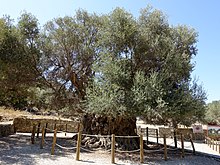
The history of the cultivated olive tree goes back at least to the Bronze Age . The first archaeological finds of olive pits are over 9000 years old, but these are olives collected by humans from wild olive trees. It is not known when the wild form was cultivated as a fertile garden olive. However, archaeological finds suggest that this was around 4000 BC. Happened in Crete and Syria . Olives and especially olive oil are an important asset of the palace economy on Cretan tablets and later on Mycenaean Linear B archive tablets .
The tree was also an important supplier of charcoal, which was needed for the melting process. This was especially true for Cyprus, which was the most important copper producer. There, the olive tree provided 71% of the charcoal studied between the Bronze Age and the Hellenistic Empires.
Egypt
In Egypt, olives were grown on the Mediterranean coast, the Bahariyya , Dachla , Charga and Siwa oases and on the Sinai . The first evidence comes from the 18th dynasty (approx. 1500 BC). Leaves of the olive tree were found in the tomb of Pharaoh Tutankhamun . In the Ptolemaic period the plant was grown more frequently, in Roman times it was very common. According to Theophrastus the olive tree was to be found in the Thebais , according to Strabo also in the Fajum .
Antiquity
In ancient Greece, the olive tree was considered the sacred tree of the goddess Athena . According to the legend, Poseidon and Athena fought for supremacy over Athens and Attica, whereupon Poseidon had a spring spring up in Athens; But Athena grew the first olive tree on the Acropolis. Then the Athenians decided that the olive tree would be more useful, and so Athena became Athens' city goddess. This olive tree was worshiped and burned when the Persians took the city. But just a few days later he drove out again, which was interpreted as a particularly good omen. In the academy stood the inviolable olive trees consecrated to Athena; According to tradition, they came from the first olive tree on the Acropolis . In Attica, even an owner was forbidden to cut down an olive tree. The victory wreath, which was awarded to the winners at the Olympic Games, was wound from the branches of the wild olive tree ( kotinos kallistephanos "beautifully crowned olive tree"). According to Pausanias , Diodor and Strabo, this was brought to Olympia by the dactylic Herakles - not to be confused with the well-known hero - by the Hyperboreans . The first Olympic champion to be honored with the olive branch was the Messenian Daikles .

The god of oil construction was Aristaios , who was especially worshiped by the oil farmers in Sicily. The olive tree is believed to have been in the 7th century BC. BC came to this island.
In Homer there are numerous references to the use of the olive tree. The wood of the wild olive tree was used for making ax handles because of its great strength . The oil was used to anoint the body, but was reserved for the rich and noble as a luxury good, as described in the Iliad .
Bible
The frequent references in the Bible to the tree and its products, to its abundance in the land of Canaan and the important place it has in the economy of Syria, underscore its importance in the Middle East. In the early Byzantine period, the export of olive oil was the economic basis for hundreds of villages in the Dead Cities area for their heyday from the 4th century onwards. The tree became a symbol of peace. In the arid climate of the Middle East, oil soon became an important and healthy staple food. This important role of the olive tree is reflected in the economy , religion and art as well as the many myths . According to the Bible, the oil fruit was promised to the Jews in the promised land , it formed a significant part of wealth and, next to the fig tree and vine, was the image of prosperity and civic happiness. The immigrant Israelites already found the olive tree. Kings David and Solomon promoted its cultivation. The oil was used for food, for offerings, as fuel oil and for anointing the hair and the whole human body .
In Christianity , too , the dove with the olive branch is a symbol of peace . According to the Bible, Noah sent a dove after the Flood. She returned with an olive branch in her beak ( Gen 8, 11 EU ): the earth was green again, life was back. Jesus stood among olive trees in the garden of Gethsemane just before his crucifixion dialogue with God ( Mt 26.36 to 46 EU ). Paul illustrated the relationship between paganism and Judaism with a wild and a noble olive tree ( Rom 11 : 13-24 EU ). Wild olives ( Olea europea subsp. Oleaster or Olea europea var. Sylvestris ) grow on the coast of the Mediterranean Sea. An African variant ( Olea africana Mill. Or Olea chrysophylla Lam.) Occurs in Yemen and in the Gebel-Elba region in the extreme south of Egypt (see also homeland ).
The olive tree as a symbol

The olive tree with Aesop and Romulus
In his fable The Reed and the Olive Tree , Aesop describes the olive tree as a symbol of apparent strength, which does not withstand real loads, but breaks - in contrast to the seemingly weak but flexible reed .
Also with Romulus , the olive tree in the fable The Trees and Man is characterized by its strong wood, which is therefore best suited of all types of wood for the manufacture of an ax style.
Homer's olive tree
“But the Atreid, taking off his sword full of silver
humps, jumped up on Peisandros. He lifted the shimmering battle-ax
Under the shield, the honor, adorned with the
stem of an olive tree, smooth and long; and they pushed against each other at the same time. "
“Inside the enclosure was an extensive shading olive tree,
strong and blooming; the trunk was like columns in thickness.
Around this I built
our marriage chamber of densely arranged stones , and vaulted the upper ceiling,
and closed the gate with firmly interlocking wings.
Then I cut the branches of the wide-
shaded olive tree, And hold the trunk at the root, smooth it all around
Artificially and beautifully with the ore, and according to the measure of the standard;
Carved it at the foot of the bed, and bored it around with the drill,
added planks to it, and built the delicate bed,
which was adorned with gold and silver and ivory;
And pulled through it with straps of purple bull skin. "
The olive tree in the Bible and Christianity
“Towards evening the dove came back to him and, behold, it had a fresh olive branch in its beak. Noah then knew that the water on earth had decreased. "
Hansjörg Bräumer recognizes a “sign of salvation” in the olive branch that the dove brings to Noah and continues that “oil leaf and olive branch [...] have since [...] been emblems of peace and salvation”.
“When the Lord your God leads you into a splendid land, a land with streams, springs and groundwater that gushes out in the valley and on the mountain, a land with wheat and barley, with vine, fig tree and pomegranate tree, a land with olive tree and honey, a land in which you do not have to eat poorly your bread, in which you lack nothing, a land whose stones are of iron, from whose mountains you extract ore; If you eat there and become full and praise the Lord your God for the magnificent land that he has given you, then take care and do not forget the Lord your God, do not disregard his commandments, legal decisions and statutes to which I commit you today! "
Here the olive tree is lined up with a variety of other symbols that, taken as a whole, describe abundant prosperity and life in abundance.
“Once the trees arose to anoint themselves a king, and they said to the olive tree: Be our king! The olive tree said to them: Have I already given up my fat, which gods and men honor in me, and will I go to sway over the trees? "
Martin Holland describes the olive tree as a “valuable tree” in the context of this passage from the Bible.
“If, however, some branches have been broken off, but you have been grafted in as a branch from the wild olive tree in the midst of them and thus received a share in the powerful roots of the noble olive tree, then do not boast about the other branches! But if you boast, you should know: It is not you who carry the root, but the root carries you. "
William Barclay writes about this in his exegesis of Romans : "Paul imagines the Gentiles as the branches of a wild olive tree that are grafted onto the olive tree in the garden, namely Israel."
The olive as a symbol of the Virgin Mary was used by the painters of the Sienese school because they wanted to avoid the traditional symbol of the lily , which was also the symbol and coat of arms of the competitor Florence . An example of this is the picture of the Annunciation by Simone Martini from 1333 in the Uffizi , in which the Archangel Gabriel holds an olive branch in his hand instead of the usual lily.
The olive tree in the Koran
“And it is he who made water come down from heaven. And through it we have produced plants of all kinds, [...] and the olive and pomegranate trees [...]. "
" Rudi Paret "
“Allah is the light of heaven and earth. Its light can be compared to a niche with a lamp in it. The lamp [...] burns (with oil) from a blessed tree, an olive tree that is neither east nor west, and whose oil is almost already bright, (still) without fire (at all) having reached it [...]. "
"Rudi Paret"
The olive tree in modern times
“The olive trees are very characteristic, and I try very hard to capture that. It's silver, which sometimes plays into the blue, sometimes into the green, bronze-colored and almost white on a yellow, pink, purple or orange floor that goes all the way to a dull red ocher ... One day I might make something very personal out of it, as I do with them I made sunflowers for the yellow tones. "
literature
- Mei-chen Chang, Lien-ching Chiu, Zhi Wei, Peter S. Green: Olea europaea . In: Wu Zheng-yi, Peter H. Raven (Ed.): Flora of China . Volume 15: Myrsinaceae through Loganiaceae . Science Press / Missouri Botanical Garden Press, Beijing / St. Louis 1996, ISBN 0-915279-37-1 , pp. 296 (English). , PDF file (section description).
- Fritz Grohmann: Flora of West Pakistan 59: Oleaceae . Stewart Herbarium, Gordon College (et al.), Rawalpindi 1974, p. 10 ( online ). (Section description).
- The olive tree at Plant for the Future. (Usage section).
- René TJ Cappers: Roman foodprints at Berenike. Archaeobotanical evidence of subsistence and trade in the Eastern Desert of Egypt. Cotsen Institute of Archeology, University of California, Los Angeles 2006, ISBN 1-931745-26-9 .
- Victor Hehn: Olive, Wine and Fig. Cultural-historical sketches. Edited by Klaus von See with the assistance of Gabriele Seidel-Leimbach. Insel, Frankfurt am Main 1992, ISBN 3-458-33127-1 .
- Alexander von Lingelsheim: Oleaceae. Oleolidae. Fraxinae et Syringeae. In: Adolf Engler : The plant kingdom. Volume 72, W. Engelmann, Leipzig 1920, online .
- Charles R. Metcalfe, L. Chalk: Anatomy of the Dicotyledons. 3 volumes, Oxford University Press, Oxford ²1987–1989, ³1998, ISBN 0-19-854593-2 .
- DB Sandy: The production and use of vegetable oils in Ptolemaic Egypt. In: Bulletin of the American Society of Papyrologists. Suppl. 6, 1989, pp. 1-136.
Web links
- Instructions for cultivation as a pot or container plant at www.kuebel Pflanzeninfo.de
- The Olive - Liquid Gold (MP3; 20 MB) Podcast for the radioWissen broadcast on July 24, 2014
Individual evidence
- ↑ The old olive tree of Vouves, an important landmark of Chania. kathimerini.gr, accessed February 23, 2016 (Greek).
- ↑ El olivo más viejo de España tiene 1,701 años y está en Ulldecona (German: The oldest olive tree in Spain is 1701 years old and is in Ulldecona) Lavanguardia.com, accessed on February 23, 2016 (Spanish).
- ^ Diego Barranco, Ricardo Fernández-Escobar, Luis Rallo: El cultivo del olivo. 3. Edition. Junta de Andalucía. Consejería de Agricultura y Pesca; Ediciones Mundi-Prensa, Sevilla / Barcelona 1999, ISBN 84-7114-819-6 .
- ↑ Hans-Dieter Belitz & W. Grosch: Textbook of food chemistry. 4th, revised. Edition, corrected reprint. Springer, Berlin 1995, ISBN 3-540-55449-1 .
- ↑ Carl von Linné : Species Plantarum . Volume 1, Impensis Laurentii Salvii, Holmiae 1753, p. 8, digitized
- ↑ PS Green: A revision of Olea L. (Oleaceae). In: Kew Bulletin. Volume 57, No. 1, 2002, pp. 91-140, JSTOR 4110824 .
- ↑ Pitta Joffe: Olea europaea subsp. africana. Pretoria National Botanical Garden 2002 (description and pictures).
- ↑ a b c d e Rafaël Govaerts (Ed.): Olea europaea. In: World Checklist of Selected Plant Families (WCSP) - The Board of Trustees of the Royal Botanic Gardens, Kew . Retrieved November 30, 2018.
- ↑ Djamel Baali-Cherif, Guillaume Besnard: High Genetic Diversity and Clonal Growth in Relict Populations of Olea europaea subsp. laperrinei (Oleaceae) from Hoggar, Algeria. In: Annals of Botany. Volume 96, No. 5, 2005, pp. 823-830, doi: 10.1093 / aob / mci232 (English).
- ↑ Bernd Imgrund: 111 Cologne places that you have to see. emons, Cologne 2008, ISBN 3-89705-618-6 , p. 146.
- ↑ Olives from Mörbisch. orf.at , January 4, 2018, accessed January 5, 2018.
- ↑ La recogida mecanizada nocturna de aceitunas puede provocar la muerte de 2,600,000 de aves. Ecologistas en Acción, November 26, 2018 (Spanish).
- ↑ Informe sobre el impacto generado por la explotación del olivar en superintensivo sobre las especies protegidas en Andalucía. Junta de Andalucía, Dirección General de Gestión del Medio Natural y Espacios Protegidos [2018] (Spanish).
- ↑ cf. Also answer of the European Commission of March 12, 2019 to a question from Carolina Punset ( ALDE ): Migratory birds endangered by mechanized olive harvesting. .
- ^ Correspondence: Luis P. da Silva and Vanessa A. Mata: Stop harvesting olives at night - it kills millions of songbirds. In: Nature . Vol. 569, No. 192, May 7, 2019, doi : 10.1038 / d41586-019-01456-4 .
- ↑ Millions of songbirds vacuumed to death during Mediterranean olive harvest. The Independent , May 16, 2019 (English).
- ↑ Lars Fischer: Sucker of horror: Millions of birds die in the olive harvest. In: Spektrum.de . May 28, 2019, accessed June 1, 2019 .
- ↑ Spiegel online: Tree dieback: Fire bacteria destroys olive groves in southern Italy , accessed on November 28, 2013.
- ↑ Badische-zeitung.de , March 26, 2015, Julian Müller-Meiningen: Fire bacteria kills olive trees in southern Italy
- ↑ Ylenia Granitto: Strategy to Contain Xylella Fastidiosa Organically Shows Promise , in: Olive Oil Times, August 25, 2016.
- ↑ Olives and olive oil in Albania. (No longer available online.) Archived from the original on November 9, 2017 ; accessed on July 26, 2017 (English).
- ↑ Olive varieties. Tunisia-Oliveoil.com (accessed May 5, 2019).
- ↑ Ezzaitouna, Institut de l'Olivier, N. Grati Kammoun & M. Khlif, 2001
- ↑ Olive stones. Biomass-Center.com ( Memento from December 16, 2013 in the Internet Archive )
- ↑ a b c Crops> Olives. In: FAO production statistics for 2018. fao.org, accessed on March 21, 2020 .
- ^ Michael Gareth Brown: Landscapes of Settlement in South-east Cyprus. The Late Bronze Age Origins of a Phoenician Polity. Incorporating the results of fieldwork by the author at Pyla-Kokkinokremos 2007–2009 , thesis, University of Edinburgh, 2011, p. 24.
- ↑ René TJ Chappers, Roman Footprints at Berenice. Los Angeles 2006, p. 15.
- ↑ Flaggenlexikon.de , accessed on September 1, 2010.
- ↑ Aesop : The reed and the olive tree in the Gutenberg-DE project ( archive version )
- ↑ Stefan Feddern: The ancient fictionality discourse . Walter de Gruyter GmbH & Co KG, Berlin / Boston 2018, ISBN 978-3-11-055055-9 , 7.3, fiction as a playful joke, p. 539 ( google.de [accessed on January 23, 2020]): “After an ax was made, a person demanded that the trees give him a handle made of wood that was strong. All trees were called the olive tree to give the wood. "
- ^ Homer : Iliad in the Gutenberg project - DE translation by Johann Heinrich Voss
- ↑ Homer : Odyssey in the Gutenberg project - DE translation by Johann Heinrich Voss
- ↑ a b c d standard translation
- ↑ Hansjörg Bräumer : Wuppertal Study Bible . Ed .: Gerhard Maier and Adolf Pohl. 2nd Edition. AT 1. SCM R. Brockhaus im SCM-Verlag, Witten 2011, ISBN 978-3-417-25151-7 , Das first Book of Mose, Part 1, Chapters 1 to 11, p. 180–181 (special edition).
- ↑ Martin Holland : Wuppertal Study Bible . Ed .: Gerhard Maier and Adolf Pohl. 2nd Edition. AT 3. SCM R. Brockhaus im SCM-Verlag, Witten 2011, ISBN 978-3-417-25151-7 , The Book of Judges, p. 137 (special edition).
- ^ William Barclay: Interpretation of the New Testament . Letter to the Romans. Aussaat Verlag, Neukirchen-Vluyn 2006, ISBN 978-3-7615-5519-4 , p. 160 (English: The Daily Study Bible, The Letter to the Romans . Edinburgh 1966. Translated by Dr. Elfriedelesenberg, first edition: The Saint Andrew Press, German special edition: 17 volumes in a slipcase).
